The Capped Bust coinage of the United States consisted of a half dime, dime, quarter and half dollar. [1]
The Capped Bust coinage of the United States consisted of a half dime, dime, quarter and half dollar. [1]
John Reich designed this capped-head concept of Liberty, and it was modified by Chief Engraver of the Mint, William Kneass. It proved to be a popular design and lasted from 1807 to 1839 on the half dollar, 1815 to 1838 on the quarter, 1809 to 1837 on the dime, and 1829 to 1837 on the half dime. [1] All four of these coin were struck in 89.2% silver and 10.8% copper. [2] [3] [4] [5]
There was also a gold design created by engraver Robert Scot created in 1795, also called the Capped Bust, although it is more popularly known as the "Turban Head" because of its unusual, exotic appearance. The Turban design was used on the gold Quarter Eagle, Half Eagle, and Eagle from 1795 to 1834. [6] On the Quarter and Half Eagles, the Turban design was replaced with the regular Capped Bust design in 1808 and 1807, respectively, [7] while the Eagle, having been out of production since 1804, adopted the "Coronet" Liberty Head design in 1838. [8]
The obverse of the 2008 Andrew Jackson's Liberty First Spouse coin and medal features the Capped Bust design. [9]
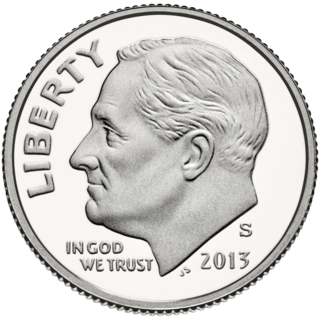
The dime, in United States usage, is a ten-cent coin, one tenth of a United States dollar, labeled formally as "one dime". The denomination was first authorized by the Coinage Act of 1792.
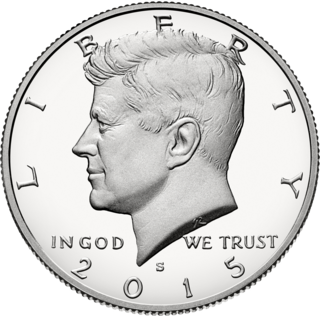
The half dollar, sometimes referred to as the half for short or 50-cent piece, is a United States coin worth 50 cents, or one half of a dollar. In both size and weight, it is the largest United States circulating coin currently produced, being 1.205 inches in diameter and 0.085 in (2.16 mm) in thickness, and is twice the weight of the quarter. The coin's design has undergone a number of changes throughout its history. Since 1964, the half dollar depicts the profile of President John F. Kennedy on the obverse and the seal of the president of the United States on the reverse.
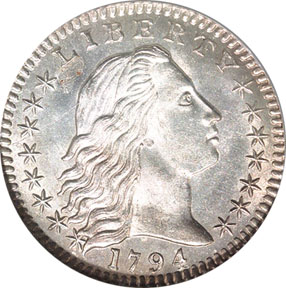
The half dime, or half disme, was a silver coin, valued at five cents, formerly minted in the United States.
Below are the mintage figures for the United States cent.

The half cent was the smallest denomination of United States coin ever minted. It was first minted in 1793 and last minted in 1857. It was minted with five different designs.
The Seated Liberty portrait designs appeared on most regular-issue silver United States coinage from 1836 through 1891. The denominations which featured the Goddess of Liberty in a Seated Liberty design included the half dime, the dime, the quarter, the half dollar, and until 1873 the silver dollar. Another coin that appeared exclusively in the Seated Liberty design was the twenty cent piece. This coin was produced from 1875 to 1878, and was discontinued because it looked very similar to the quarter. Seated Liberty coinage was minted at the main United States Mint in Philadelphia, as well as the branch mints in New Orleans, San Francisco, and Carson City.

The Seated Liberty dollar was a dollar coin struck by the United States Mint from 1840 to 1873 and designed by its chief engraver, Christian Gobrecht. It was the last silver coin of that denomination to be struck before passage of the Coinage Act of 1873, which temporarily ended production of the silver dollar for American commerce. The coin's obverse is based on that of the Gobrecht dollar, which had been minted experimentally from 1836 to 1839. However, the soaring eagle used on the reverse of the Gobrecht dollar was not used; instead, the United States Mint (Mint) used a heraldic eagle, based on a design by late Mint Chief Engraver John Reich first utilized on coins in 1807.

The United States large cent was a coin with a face value of 1/100 of a United States dollar. Its nominal diameter was 11⁄8 inch (28.57 mm). The first official mintage of the large cent was in 1793, and its production continued until 1857, when it was officially replaced by the modern-size one-cent coin.

The quarter eagle was a gold coin issued by the United States with a value of two hundred and fifty cents, or two dollars and fifty cents. It was given its name in the Coinage Act of 1792, as a derivation from the US ten-dollar eagle coin.
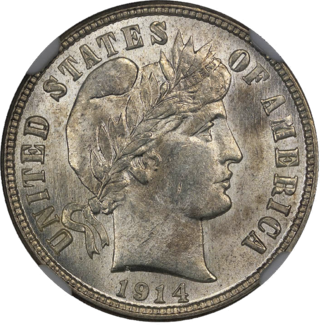
The Barber coinage consists of a dime, quarter, and half dollar designed by United States Bureau of the Mint Chief Engraver Charles E. Barber. They were minted between 1892 and 1916, though no half dollars were struck in the final year of the series.
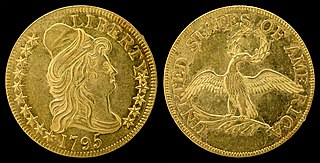
The half eagle is a United States coin that was produced for circulation from 1795 to 1929 and in commemorative and bullion coins since 1983. Composed almost entirely of gold, its face value of five dollars is half that of the eagle coin. Production of the half eagle was authorized by the Coinage Act of 1792, and it was the first gold coin minted by the United States.
A type set is a coin collection based on coin design or type. Traditional collections consist of all dates within a series such as state quarters or Lincoln cent.

"Draped Bust" was the name given to a design of United States coins. It appeared on much of the regular-issue copper and silver United States coinage, 1796–1807. It was designed by engraver Robert Scot.
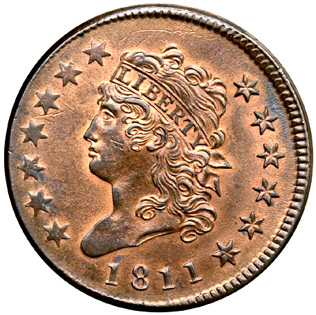
The Classic Head was a coin design issued by the United States Mint in the early 19th century. It was introduced for copper coinage in 1808 by engraver John Reich and later redesigned by Chief Engraver William Kneass.

The Coronet large cent was a type of large cent issued by the United States Mint at the Philadelphia Mint from 1816 until 1857.

The Turban Head eagle, also known as the Capped Bust eagle, was a ten-dollar gold piece, or eagle, struck by the United States Mint from 1795 to 1804. The piece was designed by Robert Scot, and was the first in the eagle series, which continued until the Mint ceased striking gold coins for circulation in 1933. The common name is a misnomer; Liberty does not wear a turban but a cap, believed by some to be a pileus or Phrygian cap : her hair twisting around the headgear makes it resemble a turban.
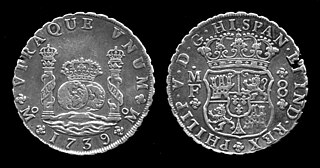
The numismatic history of the United States began with Colonial coins such as the pine tree shilling and paper money; most notably the foreign but widely accepted Spanish piece of eight, ultimately descended from the Joachimsthaler and the direct ancestor of the U.S. Dollar.
Flowing Hair coinage was issued in the United States between 1793 and 1795. The design was used for the first half dime, half dollar, dollar, and the first two large cents.

The United States Sesquicentennial coin issue consisted of a commemorative half dollar and quarter eagle struck in 1926 at the Philadelphia Mint for the 150th anniversary of American independence. The obverse of the half dollar features portraits of the first president, George Washington, and the president in 1926, Calvin Coolidge, making it the only American coin to depict a president in his lifetime.
Below are the mintage figures for the United States quarter.